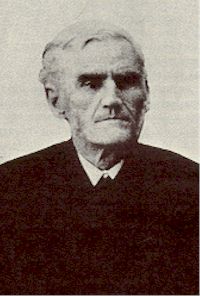|
William Orcutt Cushing
William Orcutt Cushing (31 December 1823 – 19 October 1902) was an American Unitarian minister and hymn writer from Hingham, Massachusetts. Personal lifeCushing was born in 1823 in Hingham to Unitarian parents.[1] When he was a teenager and started to read The Bible alone, he became a follower of the Orthodox Christian school of thought. When he was 18, he stated that he felt that God wanted him to become a minister.[2] Cushing remained true to Christian principles throughout his life. He once gave all of his life savings of $1,000 (approximately $18,400 in 2013) to a blind girl in order for her to receive an education.[3] MinistryCushing started his training to become a Unitarian minister based along his parents' theology.[4] His first posting as an ordained minister was to Searsburg, New York, west of Trumansburg. There he met his future wife, Hena,[1][5] and they were married in 1854. In the same year, Cushing wrote his first hymn, "When he Cometh",[2] based on Malachi 3:17, for children in his Sunday School.[6] Cushing then later went on to minister in a number of locations around New York until 1870 when Hena died, requiring Cushing to return to Searsburg. Shortly afterwards, Cushing suffered from a "creeping paralysis" that caused him to lose his voice, requiring him to retire from the ministry after 27 years in it.[6] Hymn writingAfter having to retire from the ministry, Cushing asked God for something to do to occupy his time. He discovered he had a talent for hymn writing and made that a way to keep busy after work in the ministry.[6] Throughout the rest of his life, Cushing wrote 300 hymns including "The Name of Jesus" and "Home at Last".[1] In 1880, he co-wrote "Follow On" with Robert Lowry and W. Howard Doane. This hymn became popular and was associated with The Salvation Army; its tune was adopted by Scottish association football club, Rangers as the basis for their club anthem, "Follow Follow".[7] DeathCushing died on 19 October 1902 in Lisbon Center, New York. He was buried in the Jones Cemetery, near Searsburg.[1] References
|
||||||||||||||||||||||
